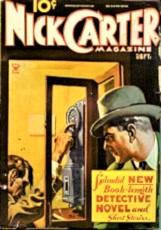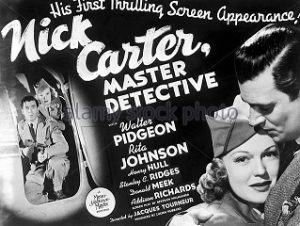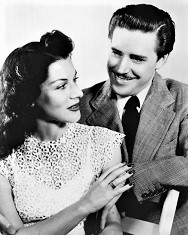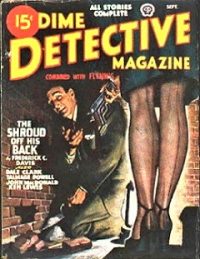
 Nick Carter, Master Detective (1943-1955) aired “The Case of the Bearded Queen” on September 7, 1947. This is the 14th Nick Carter episode we’ve run since 2009, the last being February of this year. Carter’s history is long, covers numerous media, and is one of the more fascinating we’ve come upon. To crib from one of our earlier entries for new listeners, and slightly tweaked with new material, Nick Carter on radio ran a respectable twelve years, from 1943-1955, but the famous detective’s history begins much earlier. During the post-Civil War era known as Reconstruction, a short story featuring Carter appeared in an obscure fiction paper (The New York Weekly) in 1886 (predating the first Sherlock Holmes story by two years). The publisher was none other than Street & Smith, a fledgling, struggling publishing firm which would later become the most dominant pulp magazine publisher in the world. Among its later titles would be Astounding Science Fiction (now Analog), the only magazine from Street & Smith to survive the pulp magazine crash of the 1950s.
Nick Carter, Master Detective (1943-1955) aired “The Case of the Bearded Queen” on September 7, 1947. This is the 14th Nick Carter episode we’ve run since 2009, the last being February of this year. Carter’s history is long, covers numerous media, and is one of the more fascinating we’ve come upon. To crib from one of our earlier entries for new listeners, and slightly tweaked with new material, Nick Carter on radio ran a respectable twelve years, from 1943-1955, but the famous detective’s history begins much earlier. During the post-Civil War era known as Reconstruction, a short story featuring Carter appeared in an obscure fiction paper (The New York Weekly) in 1886 (predating the first Sherlock Holmes story by two years). The publisher was none other than Street & Smith, a fledgling, struggling publishing firm which would later become the most dominant pulp magazine publisher in the world. Among its later titles would be Astounding Science Fiction (now Analog), the only magazine from Street & Smith to survive the pulp magazine crash of the 1950s.
(Top right: Nick Carter Magazine for September 1935 )
Award-winning radio historian Elizabeth McLeod notes that, “Within a decade, an ongoing series of Nick Carter novels vaulted [Street & Smith] to the front ranks of dime-novel publishers, and made Nick himself a national institution. Nick’s own magazine, The New Nick Carter Weekly, would carry the detective into the twentieth-century.” By 1915, however, the then titled Nick Carter Weekly became Street and Smith’s Detective Story Magazine, a true pulp magazine and S&S’s initial entry into this new format. Again, from Elizabeth McLeod: “Detective Story Weekly soon became Street and Smith’s flagship publication. With the rise of radio in the 1920s, it became the firm’s entree into the broadcast medium. The Street and Smith Detective Story Hour became a favorite of listeners at decade’s end, with elaborate tales of murder and crime hosted by a mysterious narrator introduced only as “The Shadow.” While Nick Carter himself did not appear on the program, his spirit was very much in evidence in the various detective characters that populated the stories.” Of course, we all know what happened next. The mysterious voice only introducing the S&S Detective Story Hour became so popular that S&S launched The Shadow magazine in 1931, and shortly thereafter S&S added Doc Savage to its pulp adventure line. Amidst all of this activity Nick Carter was even given his own magazine (again) in 1933, proving the character’s resiliency and staying power–he was now 47 years old.

 Nick Carter Magazine ran for 40 issues, from March 1933 to June 1936, the final six issues slightly retitled as Nick Carter Detective Magazine. While the magazine had folded, its long-running character still lived, for in 1939 Hollywood picked up the movie rights and produced three “B” Carter films starring noted actor Walter Pidgeon* (who later would star in the classic 1956 SF film Forbidden Planet). A mere three years later, Nick Carter would rise from the dead yet again in his own radio series, Nick Carter, Master Detective. The show’s producer and often the writer, Sherman “Jock” MacGregor, would enlist some of the best writers in the business to script Carter’s episodes, including Robert Arthur and David Kogan of Mysterious Traveler fame, the creator of The Shadow, Walter Gibson, and none other than legendary SF author Alfred Bester (one of which Bester-written episodes, “Chemical Chickens,” we ran in March of 2014 here). Lon Clark played Nick Carter throughout its 12-year run, ably supported by first Helen Choate until mid-1945 and then Charlotte Manson (photo above right with Lon Clark) as Nick’s intelligent, perky secretary Patsy Bowen. Other mainstay characters included Police Sergeant Matty Mathieson, young newspaper reporter Scubby Wilson, and scruffy old veteran of the crime game Waldo McGlynn.
Nick Carter Magazine ran for 40 issues, from March 1933 to June 1936, the final six issues slightly retitled as Nick Carter Detective Magazine. While the magazine had folded, its long-running character still lived, for in 1939 Hollywood picked up the movie rights and produced three “B” Carter films starring noted actor Walter Pidgeon* (who later would star in the classic 1956 SF film Forbidden Planet). A mere three years later, Nick Carter would rise from the dead yet again in his own radio series, Nick Carter, Master Detective. The show’s producer and often the writer, Sherman “Jock” MacGregor, would enlist some of the best writers in the business to script Carter’s episodes, including Robert Arthur and David Kogan of Mysterious Traveler fame, the creator of The Shadow, Walter Gibson, and none other than legendary SF author Alfred Bester (one of which Bester-written episodes, “Chemical Chickens,” we ran in March of 2014 here). Lon Clark played Nick Carter throughout its 12-year run, ably supported by first Helen Choate until mid-1945 and then Charlotte Manson (photo above right with Lon Clark) as Nick’s intelligent, perky secretary Patsy Bowen. Other mainstay characters included Police Sergeant Matty Mathieson, young newspaper reporter Scubby Wilson, and scruffy old veteran of the crime game Waldo McGlynn.
*(The first of the three Nick Carter films was 1939’s Nick Carter, Master Detective. Of interest to genre buffs is that it was directed by Jacques Tourneur, now famous for directing the following trio of Val Lewton horror films: Cat People (1943), I Walked with a Zombie (1943), and The Leopard Man (1943).)
From Nick Carter’s beginnings in 1886 through his final radio show in 1955, Carter would change with the times; from clean-living detective (actually, at the beginning of his career, Nick was a private investigator and consulting detective to the police department, much like Sherlock Holmes, and did not work as a police detective), master of disguise, to anti-espionage agent, to the bane of mad scientists or the defender of scientists beset by crooks, Nick Carter has enjoyed one of the longest surviving, most popular runs in various media for over 100 years, for when his radio show ended in 1955 he would resurface (yet again!) in a series of James Bond-type paperback novels in the 1960s which ran into the 1990s, quite a few of them written by women.
Virtually forgotten today, Nick Carter predates Dashiell Hammett’s Sam Spade, Raymond Chandler’s Philip Marlowe, and was originally inspired by the real-life exploits of private investigator Allan Pinkerton.
As for “The Case of the Bearded Queen,” in some ways it is the familiar story of teenage boys falling in with the wrong element. In this case, they are led astray by a man who draws them in with promises of easy money, and before they know it they are part of a car theft ring. But when they steal Scubby Wilson’s new car they have bitten off more than they can chew, for this sets Nick Carter on their trail. But lest you think this is the whole story, think again. It is but the first scene in a multi-act drama that soon reveals far more than a simple series of car thefts, for the story takes a left turn when Nick shows one of the youngsters why he has been duped by a most unusual bearded queen, and who his real friends are.
Play Time: 26:27
{This episode of Nick Carter aired on a Sunday. The preceding Monday, September 1st, was Labor Day and a holiday, after which the new school year would begin for the neighborhood gang. Dreading their first full week of school following the shortened first week due to Labor Day, the gang had made their usual trip to the corner newsstand that Saturday, hoping to lighten their gloomy spirits with some further detective/crime adventures in the vein of Nick Carter, Master Detective. Black Mask (1920-51) was arguably the gold standard for the genre and its issues would become collectors’ items decades later. It was a bi-monthly in 1947. Dime Detective (1921-53) was another cornerstone of the detective genre for more than 30 years, having found its niche early on and managing to keep its stories fresh enough to hold onto its faithful audience long after interest in the gang and organized crime films of the 1920s and 30s had begun to lose their appeal in the eyes of the public. It was a monthly in 1947. Ten Detective Aces (1928-49) was another popular player in the genre and though its run was a few years shorter than the other pair of magazines listed here, it offered another viable outlet for those who couldn’t get enough of the Good Guys vs. the Bad Guys with tough as nails stories that rarely failed to deliver. The magazine started out as The Dragnet Magazine, but by 1933 had changed its name to what you see below. It managed 5 issues in 1947.]
[Left: Black Mask, Sept. 1947 – Center: Dime Detective, Sept. 1947 – Right: Ten Detective Aces, Sept. 1947]



To view the entire list of weekly Old Time Radio episodes at Tangent Online, click here.